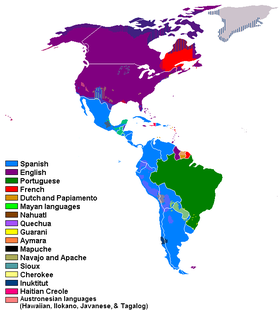Demography

Population
In 2015 the total population of the Americas was about 985 million people, divided as follows:note
- North America: 569 million (includes Central America and the Caribbean)
- South America: 416 million
Largest urban centers
There are three urban centers that each hold titles for being the largest population area based on the three main demographic concepts:
- City proper
- A city proper is the locality with legally fixed boundaries and an administratively recognized urban status that is usually characterized by some form of local government.
- Urban area
- An urban area is characterized by higher population density and vast human features in comparison to areas surrounding it. Urban areas may be cities, towns or conurbations, but the term is not commonly extended to rural settlements such as villages and hamlets. Urban areas are created and further developed by the process of urbanization and do not include large swaths of rural land, as do metropolitan areas.citation needed
- Metropolitan area
- Unlike an urban area, a metropolitan area includes not only the urban area, but also satellite cities plus intervening rural land that is socio-economically connected to the urban core city, typically by employment ties through commuting, with the urban core city being the primary labor market.citation needed
In accordance with these definitions, the three largest population centers in the Americas are: Mexico City, anchor to the largest metropolitan area in the Americas; New York City, anchor to the largest urban area in the Americas; and São Paulo, the largest city proper in the Americas. All three cities maintain Alpha classification and large scale influence.
- Urban centers within the Americas

Mexico City – Largest metropolitan area in the Americas, with a population of 22,300,000 in 2017

São Paulo – Largest city in the Americas, with a population of 12,038,175 (city) in 2016
New York City – Largest urban area in the Americas, with a population of 18,351,295 in 2010
| Country | City | City Population | Metro Area Population |
|---|---|---|---|
| Mexico | Mexico City | 8,864,000 | 22,300,000 |
| Brazil | São Paulo | 12,038,175 | 21,742,939 |
| United States | New York City | 8,405,837 | 19,949,502 |
| Argentina | Buenos Aires | 2,891,082 | 15,594,428 |
| United States | Los Angeles | 3,928,864 | 13,131,431 |
Ethnology
This section does not cite any sources. (June 2014) (Learn how and when to remove this template message) |
The population of the Americas is made up of the descendants of four large ethnic groups and their combinations.
- The Indigenous peoples of the Americas, being Amerindians, Inuit, and Aleuts.
- Those of European ancestry, mainly Spanish, British and Irish, Portuguese, German, Italian, French and Dutch.
- Those of African ancestry, mainly of West African descent.
- Asians, that is, those of Eastern, South, and Southeast Asian ancestry.
- Mestizos (Metis people in Canada), those of mixed European and Amerindian ancestry.
- Mulattoes, people of mixed African and European ancestry.
- Zambos (Spanish) or Cafuzos (Portuguese), those of mixed African and Indigenous ancestry.
The majority of the population live in Latin America, named for its predominant cultures, rooted in Latin Europe (including the two dominant languages, Spanish and Portuguese, both Romance languages), more specifically in the Iberian nations of Portugal and Spain (hence the use of the term Ibero-America as a synonym). Latin America is typically contrasted with Anglo-America, where English, a Germanic language, is prevalent, and which comprises Canada (with the exception of francophone Canada rooted in Latin Europe France—see Québec and Acadia) and the United States. Both countries are located in North America, with cultures deriving predominantly from Anglo-Saxon and other Germanic roots.
Religion
The most prevalent faiths in the Americas are as follows:
- Christianity (86 percent)
- Roman Catholicism: Practiced by 69 percent of the Latin American population, 81 percent in Mexico and 61 percent in Brazil whose Roman Catholic population of 134 million is the greatest of any nation's; approximately 24 percent of the United States' population and about 39 percent of Canada's.
- Protestantism: Practiced mostly in the United States, where half of the population are Protestant, Canada, with slightly more than a quarter of the population, and Greenland; there is a growing contingent of Evangelical and Pentecostal movements in predominantly Catholic Latin America.
- Eastern Orthodoxy: Found mostly in the United States (1 percent) and Canada; this Christian group is growing faster than many other Christian groups in Canada and now represents roughly 3 percent of the Canadian population.
- Non-denominational Christians and other Christians (some 1,000 different Christian denominations and sects practiced in the Americas).
- Irreligion: About 12 percent, including atheists and agnostics, as well as those who profess some form of spirituality but do not identify themselves as members of any organized religion.
- Islam: Together, Muslims constitute about 1 percent of the North American population and 0.3 percent of all Latin Americans. It is practiced by 3 percent of Canadians and 0.6 percent of the U.S. population. Argentina has the largest Muslim population in Latin America with up to 600,000 persons, or 1.5 percent of the population.
- Judaism (practiced by 2 percent of North Americans—approximately 2.5 percent of the U.S. population and 1.2 percent of Canadians—and 0.23 percent of Latin Americans—Argentina has the largest Jewish population in Latin America with 200,000 members)
Other faiths include Buddhism; Hinduism; Sikhism; Baháʼí Faith; a wide variety of indigenous religions, many of which can be categorized as animistic; new age religions and many African and African-derived religions. Syncretic faiths can also be found throughout the Americas.
| Country | Christians | Catholics | Protestants | None/Atheists/Agnostics | Others |
|---|---|---|---|---|---|
| Argentina | 86.2% | 76.5% | 9.7% | 11.3% | 2.5% |
| Bolivia | 95.3% | 73.7% | 21.6% | 3.7% | 1.0% |
| Brazil | 86.8% | 64.6% | 22.2% | 8.4% | 4.8% |
| Canada | 62.6% | 38.7% | 23.9% | 28.5% | 8.9% |
| Chile | 76.0% | 60.0% | 16.0% | 21.0% | 3.0% |
| Colombia | 93.9% | 80.3% | 13.6% | 5.2% | 1.7% |
| Costa Rica | 84.3% | 70.5% | 13.8% | 11.3% | 4.3% |
| Dominican Republic | 87.1% | 68.3% | 18.8% | 10.6% | 2.2% |
| Ecuador | 95.6% | 87.8% | 7.7% | 3.5% | 1.0% |
| El Salvador | 75.5% | 45.8% | 29.7% | 24.3% | 1.2% |
| Guatemala | 79.3% | 47.6% | 31.7% | 18.3% | 2.4% |
| Honduras | 83.0% | 47.9% | 35.1% | 14.3% | 2.7% |
| Mexico | 92.2% | 82.7% | 8.7% | 4.9% | 2.9% |
| Nicaragua | 81.1% | 54.3% | 26.8% | 16.8% | 2.1% |
| Panama | 90.0% | 75.0% | 15.0% | 7.0% | 3.0% |
| Paraguay | 96.8% | 90.4% | 6.4% | 1.4% | 1.8% |
| Peru | 96.7% | 81.3% | 12.5% | 1.9% | 1.4% |
| United States | 79.9% | 25.9% | 54.0% | 15.2% | 5.0% |
| Uruguay | 58.2% | 47.1% | 11.1% | 40.4% | 1.5% |
| Venezuela | 89.0% | 72.0% | 17.0% | 8.0% | 3.0% |
Languages
Various languages are spoken in the Americas. Some are of European origin, others are spoken by indigenous peoples or are the mixture of various languages like the different creoles.
The most widely spoken language in the Americas is Spanish. The dominant language of Latin America is Spanish, though the most populous nation in Latin America, Brazil, speaks Portuguese. Small enclaves of French-, Dutch- and English-speaking regions also exist in Latin America, notably in French Guiana, Suriname, and Belize and Guyana respectively. Haitian Creole is dominant in the nation of Haiti, where French is also spoken. Native languages are more prominent in Latin America than in Anglo-America, with Nahuatl, Quechua, Aymara and Guaraní as the most common. Various other native languages are spoken with less frequency across both Anglo-America and Latin America. Creole languages other than Haitian Creole are also spoken in parts of Latin America.
The dominant language of Anglo-America is English. French is also official in Canada, where it is the predominant language in Quebec and an official language in New Brunswick along with English. It is also an important language in Louisiana, and in parts of New Hampshire, Maine, and Vermont. Spanish has kept an ongoing presence in the Southwestern United States, which formed part of the Viceroyalty of New Spain, especially in California and New Mexico, where a distinct variety of Spanish spoken since the 17th century has survived. It has more recently become widely spoken in other parts of the United States because of heavy immigration from Latin America. High levels of immigration in general have brought great linguistic diversity to Anglo-America, with over 300 languages known to be spoken in the United States alone, but most languages are spoken only in small enclaves and by relatively small immigrant groups.
The nations of Guyana, Suriname, and Belize are generally consideredby whom? not to fall into either Anglo-America or Latin America because of their language differences from Latin America, geographic differences from Anglo-America, and cultural and historical differences from both regions; English is the primary language of Guyana and Belize, and Dutch is the primary language of Suriname.
Most of the non-native languages have, to different degrees, evolved differently from the mother country, but are usually still mutually intelligible. Some have combined, however, which has even resulted in completely new languages, such as Papiamento, which is a combination of Portuguese, Spanish, Dutch (representing the respective colonizers), native Arawak, various African languages, and, more recently English. The lingua franca Portuñol, a mixture of Portuguese and Spanish, is spoken in the border regions of Brazil and neighboring Spanish-speaking countries. More specifically, Riverense Portuñol is spoken by around 100,000 people in the border regions of Brazil and Uruguay. Because of immigration, there are many communities where other languages are spoken from all parts of the world, especially in the United States, Brazil, Argentina, Canada, Chile, Costa Rica and Uruguay—very important destinations for immigrants.



Comments
Post a Comment